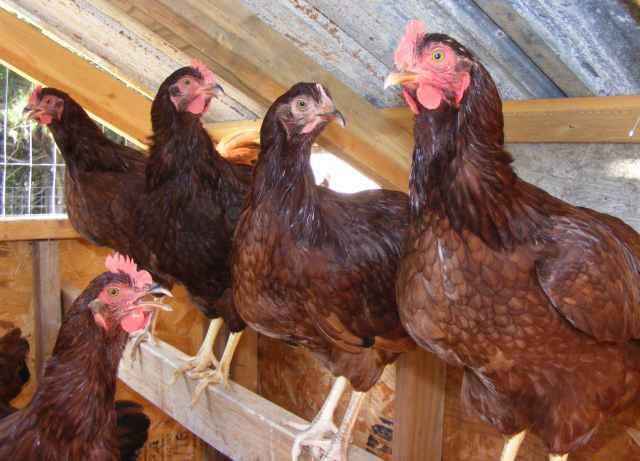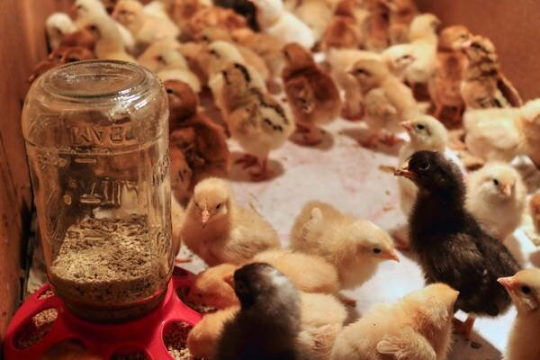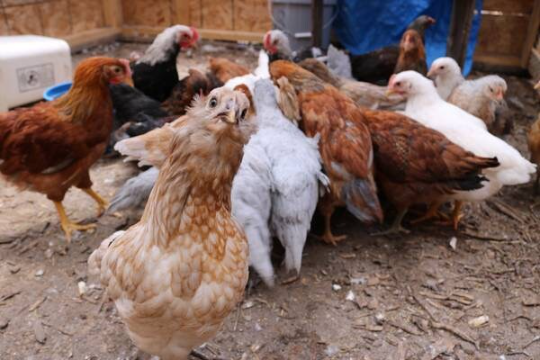New Chick Care
Horse Creek Hatchery
Baby Chick Care

Welcome to the Horse Creek family!
We hope you enjoy our chicks as much as we do and that they become productive and entertaining members of your farm and family. This guide is not all inclusive, but a general outline for how to prepare for the arrival of your chicks and care for them for the first few months of their life.
What to Bring when you pick up your chicks?
We request you to bring a small box to take your chicks home in. A box the size of the USPO priority box is fine for chicks up to a couple weeks old and smaller numbers of chicks. Please ask us ahead of time what size box we recommend for your age and number of chicks. For small chicks, less than a week old, we ask you to also bring a quart zip lock type bag with a couple cups of rice in it. Also, a small towel or washcloth to wrap the bag in. I will heat the bag for you in my microwave and that will make a nice heat source for chicks as they travel. A rice bag is not needed in warmer weather. Also, a cloth hand towel on the floor of the box makes a nice surface for the chicks to stand on while being moved and carried.
Preparing the Brooder for the Chicks Arrival
You will want to set up your brooder at least a day or two ahead of your chicks arrival. That gives you plenty of time to make any adjustments in heating ahead of time. A thermometer is invaluable. You will want your chicks to have a constant temperature of between 95 and 100 degrees their first week of life. You will want your brooder to be big enough that chicks can get away from your heat lamp into cooler areas of the box. I can not stress how important this is. Too small of an area risks fatal overheating. Too large an area will be drafty. This is vital that they have this option especially if you are not certain of temperature fluctuations with your lamp or environment. This also helps them adjust to cooler temperatures gradually at their own pace. I recommend a heat lamp with a clamp fixture equipped with a 250 watt bulb. The clamp will come in handy for adjusting your lamp up or down to get the correct temperature at the floor level of your brooder. You can find both the heat lamp and the bulb at any farm store. The first week you will keep a temperature of 95 to 100 degrees at the floor level. It is recommended to decrease the temperature by 5 degrees a week to acclimate the chicks to cooling temperature ranges. You should never go lower than 70 degrees until the chicks are fully feathered out and doing well with the gradual decrease. CAUTION: The heat lamp and bulb get very hot. Keep away from children and flammable surfaces. If you must use an extension cord, I personally would not use anything less than a 12 gauge cord.
Feed and Water should be selected and placed in brooder prior to chicks arrival. I recommend a good non-medicated chick starter with 20% protein. Our chicks are not vaccinated for coccidia. Medicated chick starter contains medication for prevention and treatment of coccidia. I prefer to treat my chicks once a month with Corrid or some other coccidia medication than to feed them a constant dose of medication. For more on coccidia treatment and prevention, please research further to decide your style of management. I would be happy to consult you further on this also. I use plain tap water, and the first week I serve it in the waterer at room temperature. You can buy vitamins and electrolytes to add to the water for a good start. If you do use additives, please follow the directions on the package. I usually give electrolytes the first or second day and then once a week after that until they move out of brooder.
Flooring in the brooder.
I use newspapers or cut up paper feed bags that I change as needed to keep clean. Some people use wood shavings, but I do not. I have found that the shavings will stick to a chicks bottom if they have a messy poo and that can cause problems. Chicks skin is very sensitive and cleaning must be very light.
Protection from Pets and Rodents.
If your brooder is open at the top, you may need to consider protection from your cat, dog, or even rodents or snakes if your brooder is in an out building. My simple solution was to use bird netting that is used to protect fruit and berry bushes from birds eating the fruit. It is inexpensive and can be cut to size and I use cloths pins to hold on the side of brooder.
Children and baby Chicks.
I do not advise kissing chicks, or chicks in face area. I also advise washing your hands after handling chicks or cleaning, watering or feeding. But, kids will be kids
.
Bio-Security and our Farm.
We may have direction for your access to various parts of our farm and around our chickens, chicks and other animals. We may ask you to spray a non-bleaching solution on your shoes. We may ask you to wash your hands with sanitizer before you handle the chicks. Children can ONLY handle chicks with permission.
Follow up Questions or Concerns.
We are always willing to answer any questions or concerns you may have with your chicks or for the life of the chicken. That said, we don't know it all, and even after having chickens for over 40 years, I still do not know it all. Following these simple instructions should eliminate most problems with your new chicks health. Our chicks will only leave here in perfect health. Transporting, follow up care and feeding is totally up to you. If you follow our suggestions and still have problems, please call us immediately. Thank you for choosing Horse Creek Homestead & Hatchery. -Amy & Jessi
FLOCK STOCK
Available:
|
8- 15 week Pure Breed Chicks & Pullets$10 Straight Run
|
Ducks
|
*Info on Barnyard Mix and Easter Eggers in the Hatchery.
More info in the Flock Stock page


